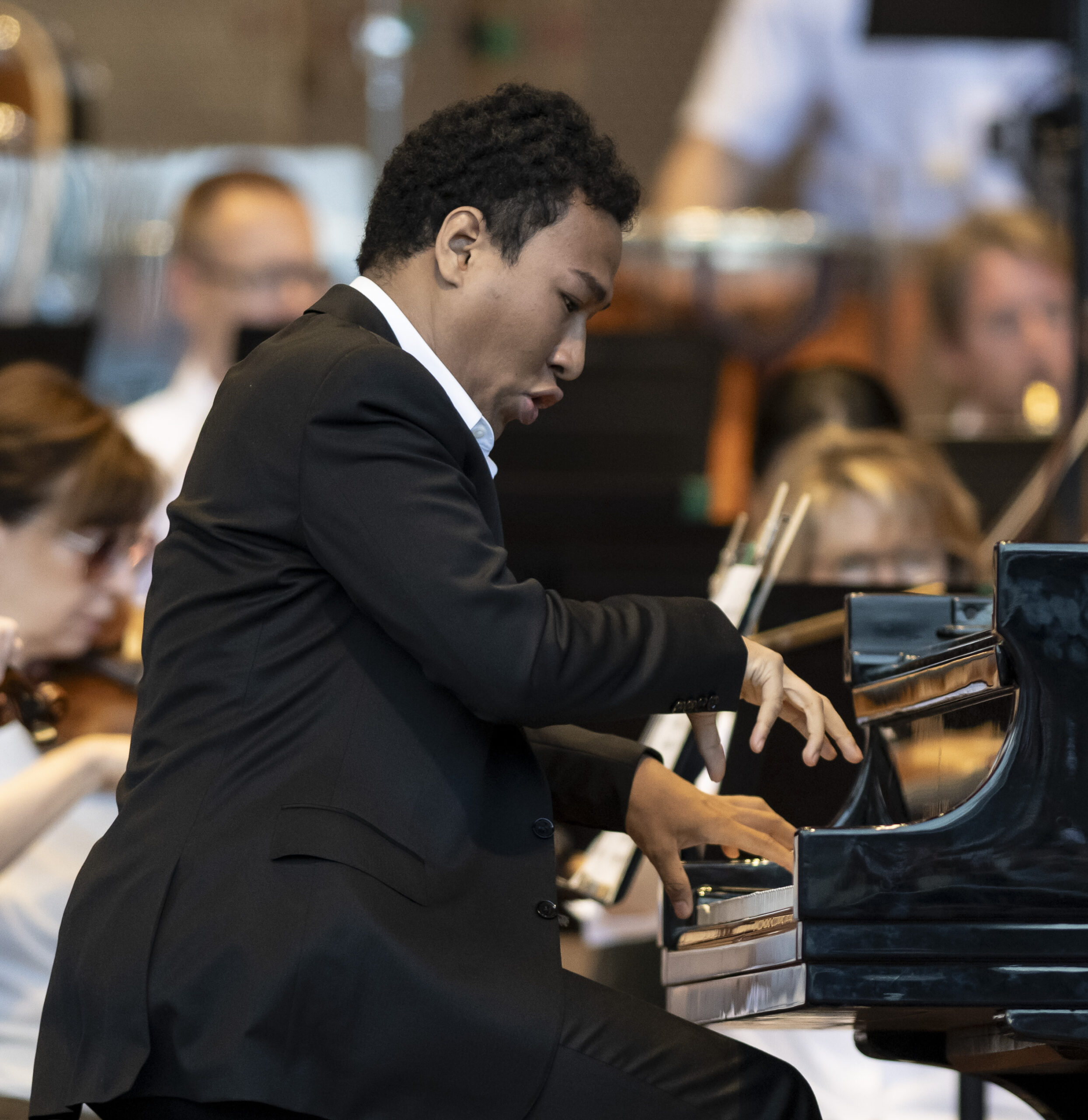Review: Grant Park Orchestra Gives an Inspired performance of Ravel, Rachmaninoff, and Hindemith

Under another beautiful evening and sunset, the Grant Park Orchestra continued its excellent season at Jay Pritzker Pavilion on Wednesday evening. Conductor Eric Jacobsen called the program “inspired” because the composers Maurice Ravel, Sergei Rachmaninoff, and Paul Hindemith based their works on the inspiration of other composers.
Headlining the concert was pianist Clayton Stephenson, who performed Rachmaninoff’s Rhapsody on a Theme by Paganini, my favorite piece by this composer. The other works were less familiar but very enjoyable: Ravel’s Le tombeau de Couperin and Hindemith’s Symphonic Metamorphosis of Themes by Carl Maria von Weber.
Jacobsen certainly set the tone. Dressed in a white suit and shirt, with bright red stockings and blue shoes, this 40-year-old cut a dynamic profile from the rostrum. He did not use a podium or score, but he did have a baton in his right hand. With arms waving overhead and body moving in the direction of his cues, Jacobsen created a delightful image to draw the audience’s attention. The concert was full of fun and frolic.

While different in substance each piece showcased the lighter side of life, even if they emerged from sadness and tragedy. That was the case with Ravel’s Le tombeau de Couperin, a four-movement suite based on the French baroque master, François Couperin, from 200 years earlier. Ravel originally composed it as a six-movement piece for solo piano, but he dropped two movements in writing an orchestral version.
As the program notes explained, this piece emerged from Ravel’s involvement in World War I. While too small to fight on the front, he drove ammunition trucks behind the lines. Many of his friends were casualties in the fighting, and their memories were encapsulated into this piece. However, rather than being mournful, it is very light and airy.
The opening “Prélude” features the upper woodwinds scampering around like mice, while the rest of the orchestra provides and colorful palette. Under Jacobsen’s lead the sounds moved effortlessly between the instruments, and he created a lilting feel. The second movement “Forlane” sounds like a jilted dance, with Ravel moving smoothly from tonal to atonal harmonies. Strangely, it feels more dance-like than the actual “Menuet” that follows. Just before the “Menuet,” Jacobsen paused to allow a bad case of sirenitis to subside. “Rigaudon” wrapped it up with the whole orchestra joining in on the fun. Mitchell Kuhn giving great solos on oboe.
After the piano was rolled onstage, Clayton Stephenson got to work, and the outcome was memorable. The Rhapsody is based on the 24th Caprice for solo violin by Nicolo Paganini. Several composers have used this theme in various forms, most notably a set of variations by Johannes Brahms.
Rachmaninoff found something that these other composers apparently never noticed. He discovered a new melody of outstanding beauty simply by inverting the theme and turning it upside down. It has come down through the ages as the most ubiquitous melody Rachmaninoff ever wrote. It shows up in many places, for example, as the tune Bill Murray’s character played on the piano in the movie Groundhog Day.
This melody forms the 18 th variation, Andante cantabile, and any good performance must include a meditative rendition of it, as well as the passages leading up to it. Stephenson was remarkable throughout, and the Grant Park Orchestra certainly passed the test. He also captured Rachmaninoff’s keyboard acrobatics, whether his hands were popping on and off the keyboard or his fingers playing melodic runs or arpeggios. He demonstrated wonderful dynamism and control.
Unfortunately, at the beginning Stephenson was a bit overpowering, and the orchestra was hard to hear. Whether he was too loud or Jacobsen simply needed to turn up the orchestra’s volume, things eventually came into balance. By the Andante cantabile, all was excellent.
After a very rousing standing ovation, Stephenson ran back onstage for a wonderful encore. The Tom and Jerry Show by Hiromi Uehara continued the evening’s fun and frolic and showcased some wonderfully fast and clean fingering.
Following a quick set change to remove the piano, the concert concluded with another rousing work, Symphonic Metamorphosis of Themes by Carl Maria von Weber by Paul Hindemith. Its five movements take music by Weber, a composer from the early 19th Century, into new and different way. The opening Allegro is a march to timpani, strings, and brass that leads to a swirling melody passed between the orchestra’s section.
The movement that really impressed me was Turandot: Scherzo. Based on the same Schiller play that Puccini used for the opera of the same name, it opens with overtones on the violins while a flute sings a high-pitched tune. It quickly spreads to the rest of the woodwinds before moving to percussion. Eventually a brass choir takes over. It gave the orchestra many opportunities to shine, and they took full advantage.
